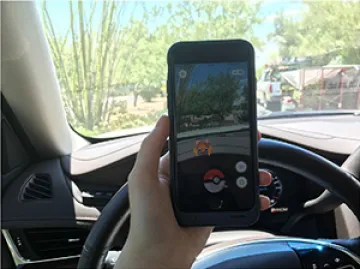UA Health Sciences Researchers Outline When Play Becomes Harmful: PokÈmon Go and the Potential for Increased Accidents
Augmented reality games like PokÈmon Go, while holding great promise to promote exercise, also increase the potential for distraction-related death, according to one of the first articles on the subject to be published in a peer-reviewed medical journal.

The article, written by University of Arizona College of Medicine Tucson surgery faculty members, Bellal A. Joseph, MD, FACS, and David G. Armstrong, DPM, MD, PhD, was published in Oxford Medical Case Reports Oct. 4. The dramatic increase in smartphone adoption and computing power on ever-more capable mobile computing platforms has been associated with a rise in reports of distraction-related injury and death.

The article describes two cases with patients presenting simultaneously to the trauma center with injuries caused by or related to augmented reality-based gameplay with the PokÈmon Go application. The article is among the first reports published in the medical literature of an augmented reality application-related injury requiring acute intervention in a trauma center.
Our world is filled with digital distractions increasing at a near logarithmic rateboth in work and in play notes co-author Dr. Armstrong, professor of surgery and director of the University of Arizona Southern Arizona Limb Salvage Alliance. What we have to figure out as a society and, frankly, as a species, is how to dose these distractions to help make our lives better and not shorter.
PokÈmon Go requires players to use their phones GPS systems to interact with virtual creatures that appear on the screen as if they were in same place as the players, and has become the most rapidly downloaded game in history. The layering of augmented reality information on top of smartphone applications has created further levels of user engagement and popularity.
In the article, the first case features a driver of a pickup truck. Alert and oriented upon admission to the trauma center, the patient volunteered that while driving the truck he lost control at 40 miles per hour. The patient was hunting PokÈmon while driving and got distracted finding one 'sitting across the road in the direct path of the truck. Attempting to flick the PokÈmon ball to capture the PokÈmon the patient lost control of the vehicle, rolling it and ejecting three passengers from the bed of the truck.

In the second case, the physician-researchers describe a single motor vehicle accident with the patient admitted to the trauma unit. The patient collided with a utility pole after swerving off the road to avoid hitting a pedestrian. The patient presented with severe pelvic pain and was found to have multiple pelvic fractures. Scene reports from bystanders and emergency medical personnel indicated that the pedestrian was engaged in a game of PokÈmon Go and had wandered into the middle of the street to catch a PokÈmon.
The researchers note that mobile entertainment applications like PokÈmon Go have the commendable ability to promote increased exercise. Other types of connected wearables, the authors said, have helped both consumers and clinicians track activity using the information to prescribe exercise much like a drug. But as their case studies show, mobile and mobile-augmented reality applications also can promote distraction.
Dr. Joseph says the team looks forward to future studies that can better characterize and classify the most common types of injuries that may result from increased use and adoption.
The paper, Potential perils of peri-PokÈmon perambulation: the dark reality of augmented reality is available at: https://www.eurekalert.org/pub_releases/2016-10/oupu-pga100416.php. To request a copy of the study, please contact: Daniel Luzer - daniel.luzer@oup.com or 212-743-6113.
About the UA College of Medicine Tucson
The University of Arizona College of Medicine Tucson is advancing health and wellness through state-of-the-art medical education programs, groundbreaking research, and advancements in patient care in Arizona and across the United States. Founded in 1967, the College ranks among the top medical schools in the nation for research and primary care and is leading the way in academic medicine through its partnership with Banner University Medicine, a new division of one of the largest nonprofit health-care systems in the country. For more information, please visit medicine.arizona.edu
About the University of Arizona Health Sciences
The University of Arizona Health Sciences is the statewide leader in biomedical research and health professions training. The UA Health Sciences includes the UA Colleges of Medicine (Phoenix and Tucson), Nursing, Pharmacy and Mel and Enid Zuckerman College of Public Health, with main campus locations in Tucson and the growing Phoenix Biomedical Campus in downtown Phoenix. From these vantage points, the UA Health Sciences reaches across the state of Arizona and the greater Southwest to provide cutting-edge health education, research, patient care and community outreach services. A major economic engine, the UA Health Sciences employs almost 5,000 people, has nearly 1,000 faculty members and garners more than $126 million in research grants and contracts annually. For more information: http://uahs.arizona.edu

